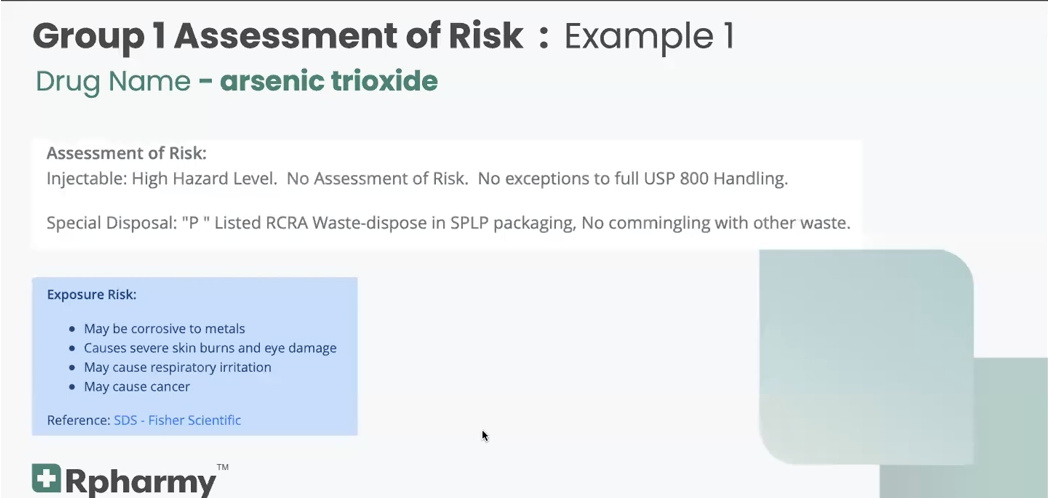As we work with our clients on USP <800> projects, the Assessment of Risk (AoR) is a common topic of conversation although there is not a lot of information available. Since March 2018, we've seen a large evolution regarding AoRs.
When we first started working with hospitals on USP <800>, we frequently saw health systems and hospitals who would say, “We’re just going to do everything the way NIOSH says to do it. We're not going to bother with creating assessments of risk.” As time went on, they realized that nurses are not really going to do everything that NIOSH says so they said, “Maybe we need to write some Assessments of Risk.” or they said, “Oh wow, our PPE costs have just exploded and I'm meeting with the VP of Finance so maybe we need to write some Assessments of Risk.” No one wants to be the one that gets called into a meeting with the materials management or the CFO to explain why our cost of chemotherapy-related PPE is so high.
How Many AoRs are enough?
We have clients who write AoRs for every drug, and conversely, we have clients who write AoRs for very few drugs or none at all. However, we are seeing that organizations that typically write very few AoRs are now writing more. The bottom line is there are no wrong answers other than not being prepared.
When the audience was asked, “How many AoRs has your organization completed?” The majority (60%) answered 1-20 AoRs. The other 40% said 51 to 150.
On the NIOSH list alone there are approximately 300 drugs. Although we know that probably half of those drugs are not allowed an AoR so they're either HD APIs or drugs requiring manipulation prior to dispensing. We have some clients that go by NIOSH Table Five and completely follow the USP or the NIOSH handling guides. The most common reason for that choice is that it is less confusing for the staff as far as handling different drugs. That goes back to the handling guides or the handling information not being at the point of care and being difficult to find.
Very few of our clients have no AORs, but they do exist. We see some with as few as 50 and some that have over 120. In the case of Group 1 antineoplastics that require manipulation prior to dispensing, clients use a blanket statement that says, “An AoR is not allowed for this drug.”
What to Know When Creating AoRs
When creating an AoR there are certain things that must be included:
- Type of hazardous drug and/or NIOSH group - Group 1, 2 or 3
- Dosage form
- Exposure risk
- Packaging manipulation
- Alternative containment strategies
Here are examples of clients’ AoRs with an explanation of each strategy.
Group One AoRs
Though most Group One medications don't typically receive a risk assessment, perhaps the pharmacy needs to communicate some information to the end user regarding these types of medication.
Here's an example of an injectable that is a “high hazard.” There are no exceptions to the full USP <800> handling, but in this instance, the client wanted to communicate how to dispose of the waste for this medication. Here you can see how the client wrote it in the Rpharmy software.

In the USP <800> seminars we’ve been to, Methotrexate is a common drug used as an example when talking about AoRs because Methotrexate is a Group One drug that comes in multiple forms. In this case, they’re showing that because Methotrexate is an antineoplastic drug and the injectable does require manipulation prior to dispensing so an AoR cannot be written for that form. However, in this instance, for the oral preparations, they are providing an AoR. Their handling guide information for administration is based on the information they provided in their AoR.

Here's another example of a client’s Group One drug where no assessment is allowed. This is the information that they wanted to communicate to their end user at the point of care.

Group Two AoRs
In this first example AoR, you see four different formulations of testosterone. What you don't see in this AoR is the NIOSH group. However, the header for the Rpharmy Rhazdrugs software always has the name of the drug and the group, as well as the therapeutic class. Here you can see the packaging, the pharmacy containment strategy and the nursing containment strategy.

Here is testosterone from a different client with two topical formulations. This particular client also has a retail department or a retail pharmacy within their organization so they've designated retail storage here and retail packaging and dispensing. Notice that they have not designated inpatient information here. Also, they marked several areas as “not applicable,” including nursing information and sterile compounding information. Suggesting that those products are utilized in the inpatient setting.

Group 3 AoRs
Here’s a client’s AoR for Dutasteride, where they document the dosage and the risk of exposure from the NIOSH category. This client decided to put the hazardous drug qualification information directly from the supplemental information in NIOSH. This is perfectly acceptable.
The client also documents the receiving and packaging information for the area as well as the fact that it's a unit dose package mitigating risk to healthcare workers. The inpatient and retail storage information, as well as the inpatient and retail packaging and dispensing information, is also documented.
Of note, the inpatient packaging and dispensing says it is for the unit dose. It says if the unit dose isn't available, then the pharmacy will unit dose with a manual packing system because we don't like to use automated packaging machines for hazardous drugs. This prevents cross-contamination.
Also, for retail, they specifically say only whole tablets and capsules are dispensed. This AoR also documents inpatient information letting the nurses know not to crush or open that capsule.

AoR Templates
Here are some fill-in-the-blank AoR templates enabling you to fill in the drug, the dosage form and all the different activities for the containment strategy information. The template also identifies how USP <800> guidelines require you to perform those activities. The columns allow you to check that box communicating whether or not an activity applies. If the activity does not apply, then you can provide an exemption for that activity.

Here’s a template populated with a few things to show you how it works. Start with the name of the drug, the route of administration, which in this case is oral and gastric tube, and the form, which is liquid. Because it’s a liquid, which could be a suspension or a solution, you will always have either dermal or inhalation exposure risk.
Here we see an exemption. This drug is exempt because it's always dispensed from Pharmacy as a final dose? Also, do the alternative containment strategies work for all of the drugs you're assessing? A tip is to include as much common information as possible.
When we look farther down the template the headers say “Handling” (which could also be called activity), “inpatient ambulatory”, and “retail specialty” meaning this organization has a retail and or specialty pharmacy. Therefore, they have a column for retail specialty and spelled out in that column how they handle different activities as well as the inpatient ambulatory and how they differ.
When the audience was asked, “Who writes AoRs in your organization?” the majority answered that the designated person is in charge of writing AoRs. Coming in second was a hazardous drug oversight committee.
Containment Strategies
This is not necessarily a typical spreadsheet but it is similar to many that come to us when we begin working with a hospital or health system. As you can see, it's color-coded with a list of drugs and then colors signaling the handling guide information and the containment strategies for those drugs. Then there are the pharmacy and nursing buckets. The next page communicates the pharmacy containment strategies with more color coding that correlates with the different drugs. This information is challenging to get through and understand.


This next image shows the nursing containment strategies. They did attempt to simplify the information, but a nurse still has to refer back to that original spreadsheet to see the drug name. It’s still a lot of information to wade through. Imagine if you’re a nurse just trying to administer medication.

Now let’s look at Rhazdrugs containment strategies. This image shows the administration for the different forms of Abacavir. Each tab illustrates how the nurse should protect themself when administering that drug. The containment philosophy or rules in this organization for disposal are also clearly communicated. Also included are this organization’s rules for receiving and storage as well as the containment for preparation of oral non-antineoplastic reproductive risk. Finally, the transport policies are shown for non-antineoplastic and reproductive risk drugs through the pneumatic tube system in their organization.


Q&A from the webinar:
Q: What drugs need assessments of risk?
An AoR is not allowed for any hazardous active pharmaceutical ingredient (HD-API). Those are usually seen in compounding facilities designated as 503b facilities but occasionally, you may see some active pharmaceutical ingredients in the inpatient pharmacy and your infusion clinics. As well as any antineoplastics that are being compounded or manipulated prior to dispensing then an AoR is not allowed for those.
You can provide an AoR for any final dosage forms and/or conveniently manufactured products you dispense in the package such as unit dose products.
Q: Are you seeing hospitals hire someone to write assessments of risk? Do you know of any companies or consultants that can write those for our organization?
I have not seen any company offering to write assessments at risk, but I have seen quite a few sites providing templates examples to create your own. There may be some consultants out there that are offering that service, but I'm not aware of them. Rpharmy does not necessarily write the AoRs, but we can assist in the process when we take on a new client. Many times we receive spreadsheets that are directly related to AoRs, and we decipher that information to make it easily readable and accessible for AoRs.
Q: Does Rpharmy provide AoRs or could you help us write them?
We do not provide AoRs because they must be created based on decisions within your organization that include site-specific design. However, we can show you what other people have done to help you create your own. There's so much information out there about AoRs. Also, reviewing the SOPs in your organization, then seeing examples of AoRs can help you make more informed decisions on which drugs need an AoR and which do not.
In the next USP <800> Preparedness webinar, we’ll talk about creating a hazardous drug list and also compare NIOSH 2016 and NIOSH 2020. Check out the events schedule and register here. Also, if you missed any of the webinars, you can watch them at your convenience here.


